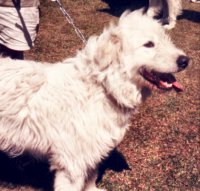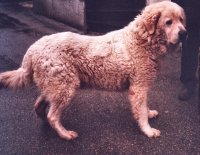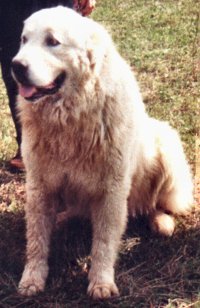
Type Marsicano
The type Marsicano
The imposing head of this type is reminiscent
of the lion. The structure of this dog is large and strong.
The breast is big, but not excessive. It measures about 70/75 cm. to
the withers and weighs between 40-60Kg. These dogs generally have a
set of teeth like shears. It is located in the area of Marsica.
Currently, this type is often used for breeding.
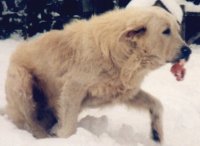
Esemplare Aquilano di proprietà del sig. Marco Petrella
The type Aquilano
This type has an imposing and large structure.
The head is as large, but longer than the Marsicano. Those belonging
to this type usually measure between 75-83cm to the withers, but in some
cases, there have been exceptionally larger animals. They usually
weigh between 60-80kg.
Juvenile Aquilano have a strong elongated form, similar to the small calf.
This aspect disappears at about 3 years of age, when they are fully
developed and assume an imposing aspect. Their teeth are similar to
‘pliers’.
The Aquilano type is common in the regions around the Gran Sasso mountains
and in the Peligna Valley.
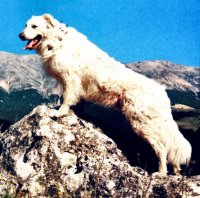
Pippo: esemplare maschio di Edorado Puglielli, Pratola
The type of Pescocostanzo
This dog remembers the actual present show dogs and is a typical
work dog.
Very smaller than the other types it is busy a wolf head and a very territorial character
tha is very appreciate for the job.
Compared to the Marsicano, structurally, this line is not excessively
large or strong, with only 68-72cm to the withers.
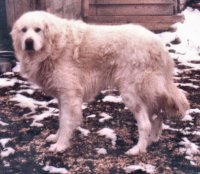
Esemplare di Marco Petrella
Pratola P. (AQ)
The type of Maiella
Located primarily in the Pescarese region and
in the Maiella Mountains, the Maiella is probably a cross between the
Aquilano and the Pescocostanzo. This line is similar in structure to
the Aquilano, with a head similar to the Pescocostanzo. In some
specimens the head is reminiscent of a bear. In character, the
Maiella is very similar to the Aquilano, and was common until the 1950’s.
The disappearance of the wolf, and the decline in the number of sheep and
shepherds has brought about a gradual reduction in this line.
One of the characteristics that has made to appreciate a lot these dogs are the presence of a thick collar of hair around the neck and to the tall part of the breast.
In some subjects the long mane and the breast very developed they confer to the dogs the aspect of a
lion.

The type Peligno
Very similar to the Aquilano of which he differentiated more for the character, it was very diffused up to the years '50.
The disappearance of the wolf and the number of shepherds has brought to one gradual reduction of
his.
The Peligno is a dog of imposing structure, which can weigh 100kg.
It has a thick coat and strong black pigmentation on the nose. This
dog has spurs on the hind legs. The large head is not like the
mastiff, but resembles a bear. These dogs are so devoted to their
flock, that they do not even allow sheep from a different flock to
approach their charges.
The Satin Hair type:
Almost extinct, with ‘shaved’ hair, this type was present in the mountains of Maiella and Morrone. Another line of imposing structure, it had the head of the Marsicano and the body type of the Aquilano.
Praticamente estinto, era presente
sulle montagne della Maiella e del Morrone ed aveva il pelo raso.
Di struttura imponente, aveva la testa che ricordava il tipo Marsicano (molossoide)
e la struttura simile al tipo Aquilano.
Some sample could still be observed to the strata of the Maiella in the flocks of the present shepherds to
Passo S. Leonardo and near the wood of S. Antonio.
The Type Maremmano.
Despite its name, this dog is also a native of
Abruzzo, where it probably had its origin.
Not excessively large, this dog is
above all, a veritable weapon against predators, yet gentle with people.
Very similar to the Pescocostanzo, this dog was derived from some
outstanding specimens that the rich Tuscan landowners brought from the
Abruzzo.
In origin, this line was formed from the best of the ‘discarded’ (1)
in Abruzzo, with a smaller build and evident ‘stains’ of blond/orange
in the hair.
However, the Maremmanis knew how to turn a ‘defect’ into an advantage,
and the Abruzzese shepherds, recognizing the best characteristics of this
dog, chose to use it to create a new line.
The fascination for the Abruzzesis was such, that they couldn’t
relinquish the exemplary qualities of the Abruzzo, remixing the lines to
create a dog very similar to the native one.
So, in the first years the 50 standards were conformed and the dogs were
called Maremmani-Abruzzesi.
Unfortunately, the majority of those who promoted the drawing up of the
standard were not Abruzzesi. In order not to penalize their own dogs,
they defined as the standard, a small dog, with the result that some lines
of the dogs present in Abruzzo today are much larger than the standard
prescribed.
